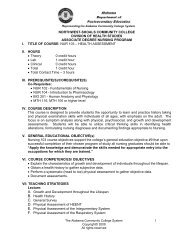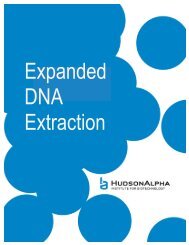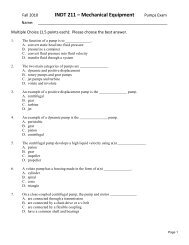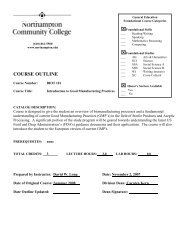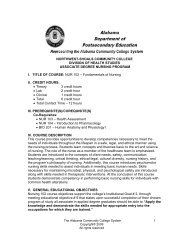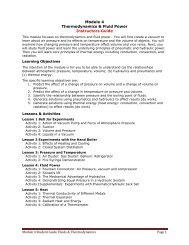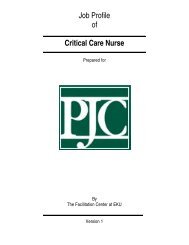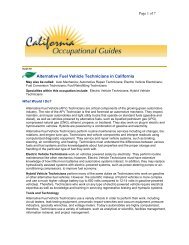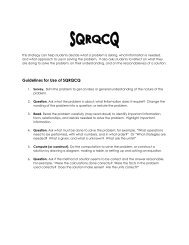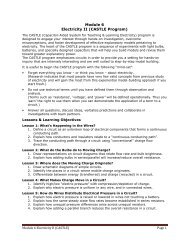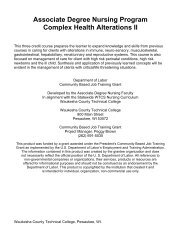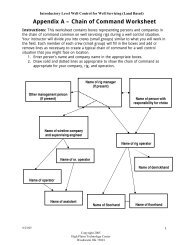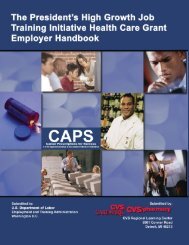Download Now - Workforce 3 One
Download Now - Workforce 3 One
Download Now - Workforce 3 One
Create successful ePaper yourself
Turn your PDF publications into a flip-book with our unique Google optimized e-Paper software.
HNPCC<br />
detecting inherited forms of cancer
HNPCC: Detecting Inherited Forms of Cancer<br />
Published by HudsonAlpha Institute for Biotechnology 2009<br />
Educational Outreach<br />
HudsonAlpha Institute for Biotechnology<br />
601 Genome Way<br />
Huntsville, Alabama 35806<br />
http://education.hudsonalpha.org<br />
Permission is hereby granted to teachers to photocopy any pages or figures in this laboratory kit for classroom use.<br />
Teachers may also make transparencies of pages in the Teacher’s guide. Requests or reprinting for photocopying for<br />
distribution outside of the typical classroom setting should be made to HudsonAlpha Educational Outreach via email at<br />
edoutreach@hudsonalpha.org.<br />
This kit is intended for educational purposes only. It is not to be used for research or diagnostic purposes.<br />
Special thanks go to Leah McRae, a life sciences teacher at Bob Jones High School in Madison, Alabama, for creating the initial<br />
version of the laboratory outline and instructor guide. The laboratory component was developed through the combined work of Dr.<br />
Bob Zahorchak and Mrs. Jennifer Carden, the 2008-09 HudsonAlpha Educator in Residence. Mrs. Kelly East developed the online<br />
supplement that accompanies this lab. Additional assistance was provided by Michelle Morris, April Reis, Kelly Hill and Griffin, Rebecca<br />
and Lisa Herod.<br />
Thanks also to Steve Ricks, Robin Nelson and the outstanding Science in Motion Biology Instructors at the Alabama Math, Science,<br />
and Technology Initiative (part of the Alabama State Department of Education) for their cooperation in this endeavor.<br />
Funding for the development of this module and its associated activities has been provided in part by the Educational Outreach<br />
Program at the HudsonAlpha Institute for Biotechnology, located in Huntsville, Alabama. The Institute, a unique partnership between<br />
scientific researchers and biotechnology companies, has a strong commitment to educating today’s youth about opportunities in<br />
biotechnology. For more information about the ongoing work at HudsonAlpha, please visit www.hudsonalpha.org.<br />
This product was partially funded by a grant awarded under the <strong>Workforce</strong> Innovation in Regional Economic Development (WIRED)<br />
Initiative as implemented by the U.S. Department of Labor’s Employment & Training Administration. The information contained in this<br />
product was created by a grantee organization and does not necessarily reflect the official position of the U.S. Department of Labor.<br />
All references to non-governmental companies or organizations, their services, products or resources are offered for informational<br />
purposes and should not be construed as an endorsement by the Department of Labor. This product is copyrighted by the institution<br />
that created it and is intended for individual organizational, non-commercial use only.<br />
1
Foreword<br />
In the broadest sense, biotechnology is the use of biological processes, organisms or systems to develop products aimed<br />
to improve some aspect of life. Biotechnology at its roots is a very old science, stretching back 7,000 years to the creation<br />
of bread, cheese, wine, and vinegar (which all depend on harnessing and modifying some biological process). The field<br />
has expanded dramatically over the last quarter century, powered by our understanding of DNA, the recipe card inside the<br />
nucleus of our cells. This recipe card provides the instructions to make proteins and all the structures of the cell.<br />
Biotechnology combines the disciplines of molecular biology, genetics, cell biology, biochemistry, and embryology, which<br />
in turn are linked to additional fields such as chemical engineering, information technology, and robotics. Over the next<br />
few years, biotechnology is poised to heavily impact several areas of society, including healthcare, the environment and<br />
agriculture.<br />
Cancer diagnostics and treatment are on the frontline of this biotechnological revolution. Researchers and clinicians are<br />
identifying new methods to identify the genes implicated in the cancer pathway and are applying the knowledge of those<br />
genes to develop targeted therapies. This laboratory exercise looks at the genes linked to hereditary nonpolyposis colorectal<br />
cancer (HNPCC), and explores the connection between family history and testing for mutations in these genes. Students<br />
will construct a pedigree of a family impacted by HNPCC and identify at-risk individuals. Students will then analyze the<br />
results of a simulated genetic test to discern which family members have inherited the genetic mutations linked to HNPCC.<br />
Additional student content including web-based exercises and activities are included in an online supplement that<br />
accompanies this activity - http://education.hudsonalpha.org/Kits/cancer.html. Career profiles of individuals who work in<br />
fields related to this activity, such as genetic counselors, are also included at this site.<br />
2
TABLE OF CONTENTS<br />
Overview 4<br />
Ti m e f r a m e 6<br />
La b o r at o r y Sa f e t y 7<br />
Teacher Background 8<br />
In s t r u c t o r Pr o t o c o l 17<br />
St u d e n t Ac t i v i t y An s w e r s 22<br />
Student handout 25<br />
Ac t i v i t y Pa r t On e: Pe d i g r e e 25<br />
Ac t i v i t y Pa r t Tw o : Ge n e t i c t e s t i n g 28<br />
Student DaTa Sheet 30<br />
HNPCC Lab Crossword 32<br />
3
HNPCC: Detecting Inherited forms of Cancer<br />
Overview<br />
This lab will provide the student with experience in drawing a family pedigree and interpreting the pedigree with respect to a<br />
specific form of inherited colon cancer. The students will then complete and analyze a simulated DNA-based diagnostic test<br />
to identify which members of a fictitious family have inherited the cancer-causing mutation. In the lab’s conclusion, students<br />
will take on the role of genetic counselor in order to discuss test results with one of the family members.<br />
Please note: this kit is intended for educational purposes only. It is not to be used for research or diagnostic purposes.<br />
Objectives<br />
1.<br />
2.<br />
AHSGE Objectives<br />
a. IV – 1, IV – 2<br />
Alabama Course of Study for Science Objectives:<br />
a. Biology: (1, 4, 6, 7, 8)<br />
b. Genetics: (3, 4, 5, 6, 7)<br />
Learning Objectives<br />
The students will:<br />
1. Construct an accurate pedigree across multiple generations<br />
2.<br />
3.<br />
4.<br />
5.<br />
6.<br />
7.<br />
8.<br />
9.<br />
Modify a pedigree using genetic testing data<br />
Recommend genetic testing and lifestyle changes for individuals based on data obtained during the activity<br />
Perform gel electrophoresis<br />
Generalize genetic testing procedures and the consequences of the results to a variety of examples<br />
Describe cancer as a multi-step process that includes the accumulation of multiple mutations<br />
Explain the role of caretaker genes in the development of cancer<br />
Role-play a genetic counselor communicating genetic testing results and the ethical dilemmas that arise from the results<br />
Role-play a genetic testing laboratory technician obtaining and analyzing testing results<br />
Suggested Unit Correlative<br />
This lab could be completed after a study on the cell cycle and mitosis or after a module on genetic patterns of inheritance.<br />
4
Materials<br />
If the kit is to be stored for more than 2 weeks, it should be kept refrigerated. Otherwise, room temperature storage is<br />
acceptable. While students are setting up the reactions, all components can be maintained at room temperature – no<br />
reagents need to be kept on ice.<br />
Included with this kit:<br />
Four (4) boxes of Student Sample box 1<br />
Each contains: DNA Ladder, Normal Control, Tumor Biopsy, Heterozygous DNA<br />
and 3 patient samples<br />
Four (4) boxes of Student Sample Box 2<br />
Each contains: 6 additional patient samples<br />
Instructor manual<br />
Student manual<br />
Required, but not included in this kit:<br />
Horizontal agarose gel electrophoresis system (for Alabama Science in Motion classrooms, the Lonza Flash Gel ® is used)<br />
Micropipettes (2-20 µl) 1-2 per gel being run – a classroom of 32 students will use four gels and need 4-8 micropipettes<br />
Power supply for electrophoresis gels<br />
Tabletop microcentrifuge<br />
Tips for micropipettes<br />
General laboratory safety instructions can be found on page 7 of this manual. A material safety data sheet and<br />
Safety Warnings/Conditions of Use agreement are found together with the packing list inside the kit.<br />
5
Timeframe and Outline<br />
Day <strong>One</strong> (Can be completed in 45-60 minutes)<br />
I. What is Hereditary non-polyposis colorectal cancer?<br />
1. Description of hereditary non-polyposis colorectal cancer (HNPCC) – Tell the students that they will be working<br />
with a family affected with HNPCC. Using the information found in the Instructor section of this manual, explain<br />
the clinical symptoms of HNPCC, the inheritance pattern and the genetic cause – initiated by a mutation in<br />
mismatch repair genes followed by the acquisition of additional mutations as part of a multi-step model.<br />
Note: additional content and student activities can be found at the accompanying online supplement - http://<br />
education.hudsonalpha.org/Kits/cancer.html.<br />
2. Have students research five additional facts on HNPCC as part of a homework assignment.<br />
II. Constructing the HNPCC family pedigree<br />
1. Teach/Review how to construct a pedigree<br />
2. Discuss the role of a genetic counselor. A profile of this career can be found at<br />
http://education.hudsonalpha.org/Career_Profiles/Genetic_Counselor.html<br />
3. Students should imagine themselves in the role of a genetic counselor as they read the description of the family<br />
with colon cancer and create the family pedigree based on the information in the description. – This can be<br />
given as a homework assignment or begun in class and completed on Day Two.<br />
Day Two (45-60 minutes depending on time to complete pedigree)<br />
II. Pedigree information continued<br />
1. Have students finish pedigree construction if this was not a homework assignment.<br />
2. Review the completed pedigree with the students and identify individuals who are at risk of developing colon cancer<br />
based on the pedigree.<br />
3. Discuss genetic testing and issues for patients to consider before agreeing to be tested.<br />
4. Optional: Have students role-play in pairs. Have one act as a genetic counselor and the other as a member of the<br />
family being studied. Students can write a summary of their discussion, the patient’s decision and an explanation<br />
statement.<br />
6<br />
Day Three (Can be completed in 45 - 60 minutes)<br />
III. Detection of HNPCC mutation using restriction digests and gel electrophoresis<br />
1. Discuss the use of restriction enzymes for the detection of the HNPCC mutation – for supporting information see<br />
the online supplement at http://education.hudsonalpha.org/Kits/cancer.html<br />
2. Discuss the career of a lab technician. (Coming soon to the HNPCC online supplement for this lab)<br />
®<br />
3. Students should load and run the Flash Gel electrophoresis system<br />
4. Record test results<br />
5. Have the students assume the role of the genetic counselor and add results to the pedigree using the Student Data<br />
Sheet questions as a guide.<br />
Optional: Have the students break into pairs as the genetic counselor and a member of the family. The genetic<br />
counselor should explain the test results and what they mean to the patient. The patient should ask questions they<br />
might have and discuss how these results make them feel. (Students could record this assignment for assessment<br />
purposes)<br />
6. Discuss the ethical issues surrounding genetic testing in this scenario and others.<br />
If the classroom is scheduled on a block format (90 minute segments), the description of HNPCC and the overview and<br />
construction of the pedigree can be performed on Day <strong>One</strong>. The pedigree could be completed as a homework assignment if<br />
needed. On Day Two the students could review the pedigree, discuss the genetic test for HNPCC and run and analyze the<br />
electrophoresis gel.
Laboratory Safety<br />
The best protection that you have while working in the laboratory is you. Following all safety guidelines and being<br />
aware of the potential for accidents can greatly minimize the possibility of an accident occurring.<br />
1.<br />
Always wear eye protection when working with laboratory chemicals or biological materials. The major potential for damage to<br />
the eyes due to liquids is from splashes or vapors.<br />
2.<br />
A laboratory coat/apron should be worn at all times when working with laboratory chemicals or biological materials.<br />
3.<br />
Gloves should be worn at all times when working with chemicals or biological materials. Remove gloves before touching<br />
commonly used surfaces such as doorknobs and computer keyboards. Wash your hands after removing gloves frequently and<br />
before leaving the lab.<br />
4.<br />
Dispose of all materials in the appropriate disposal receptacles. When in doubt always check with the instructor.<br />
5.<br />
When utilizing a gel electrophoresis apparatus, follow all electrical safety precautions.<br />
6.<br />
Never eat or drink in the lab.<br />
7.<br />
Only closed toed shoes should be worn in the lab. Open-toed shoes or sandals are inappropriate for the lab.<br />
7
Instructor Introduction & Background<br />
Note to instructor: The student guide addresses these topics in much less detail. Additional content is provided<br />
here to support the instructor in discussion the concept of genetic modification with the class.<br />
Additional student content including web-based exercises and activities can be found at the online supplement<br />
designed to accompany this laboratory exercise - http://education.hudsonalpha.org/Kits/cancer.html.<br />
What is a pedigree? A pedigree is a diagram showing family history and relationships in a concise, standardized format.<br />
It can be a very useful tool in medicine when tracking diseases through a patient’s family history. It can be used to highlight<br />
conditions or traits within a family that might have a genetic basis, make a diagnosis, determine patterns of inheritance and<br />
identify at-risk individuals. Basic pedigree notation is provided on the first page of the student handout. Pedigree notation<br />
varies somewhat, so if the basic symbols you have discussed with you students is different from what is printed, have the<br />
students make the appropriate changes on their handout.<br />
What is genetic testing? Genetic testing is any type of medical test that identifies changes in chromosomes, genes<br />
or proteins. Genetic testing is often conducted to identify the presence of specific changes that may lead to disease or<br />
predispose an individual to a particular condition. Patients will usually talk with a genetic counselor to establish a family<br />
history and to learn more about the particular disease and genetic mutation for which they are being tested, as well as<br />
the implications of the outcome of the test. If the patient decides to go forward with the testing, a DNA sample would be<br />
obtained from the patient and sent to a specially certified laboratory for analysis.<br />
In the lab, the patient’s DNA sample would be isolated and examined at the genetic region of interest. There are many ways<br />
to analyze these regions. In some cases the exact nucleotide sequence would be determined and compared to a standard<br />
sequence to check for differences.<br />
When the results have been analyzed and confirmed by the testing laboratory, either the physician or genetic counselor will<br />
review the findings with the patient. This often includes a discussion of questions such as: What do my test results mean?<br />
What should I do now? What does this mean for my children? What is the probability I can pass this on to future children?<br />
Assuming a mutation is identified, other individuals in the family may have the option of speaking with a genetic counselor<br />
and considering personal testing for the mutation in question.<br />
How are pedigrees and genetic testing related? Often a genetic family history is the first step in identifying individuals<br />
at risk for a genetic disorder who may benefit from a genetic test. Not every individual in the family will be a candidate for<br />
testing and not every candidate for testing will chose to be tested.<br />
What is cancer? Cancer is a collection of diseases that are characterized by uncontrolled growth of cells and the<br />
subsequent spread to surrounding tissues. Although each cancer type is somewhat unique, there are several common<br />
features surrounding cancer. Nearly all types of cancer are genetic in nature – in other words, cancer is caused by changes<br />
in the genes that control cell growth and division. Some changes occur in genes, called proto-oncogenes, which are<br />
normally involved in stimulating cells to divide. The mutated form of these genes, called oncogenes, lead to overstimulation<br />
and increased cell division. This can be thought of as a gas pedal on a car being stuck in the “on” position. Another group<br />
of genes, known as tumor suppressors, produce proteins that normally block cell division unless the right conditions are<br />
present. If we continue our car analogy, mutations in tumor suppressors remove these blocks, similar to cutting the brake<br />
lines.<br />
8
Although all cancers involve changes in the genes that control cell growth and division, only about 5% of cancer is strongly<br />
hereditary – caused primarily by mutations that are inherited from parent to child. Most cancers do not result from inherited<br />
mutations, but instead develop from an accumulation of DNA damage acquired during our lifetime. These cancers begin<br />
with a single “starting” cell that becomes genetically damaged at specific genes. The transformation from that initial cell into<br />
a tumor is a stepwise progression. When the cell divides, the resulting ‘daughter’ cells often acquire additional mutations in<br />
other oncogenes or tumor suppressors, becoming progressively more abnormal and ultimately invading surrounding tissues<br />
and/or spreading to other parts of the body (metastasis). The number of genetic mutations that are required to convert a<br />
genetically normal cell into a metastatic tumor varies with cancer type. These genetic changes may involve single “letter”<br />
substitutions, deletions, duplications or chromosomal rearrangements impacting vast sections of the genome.<br />
In the case of colon cancer, the development of cancer takes a number of years. Abnormal cell growth in the colon leads to<br />
the appearance of polyps (also called adenomas). These are quite common and about 25% of humans have one or more by<br />
the age of 50. A fraction of these polyps acquire the necessary mutations to become cancerous.<br />
For more information on cancer, the following educational websites may be of use:<br />
http://www.hudsonalpha.org/pages/bio101-08fall.html<br />
http://science.education.nih.gov/supplements/nih1/cancer/default.htm<br />
www.insidecancer.org<br />
www.cancerquest.org<br />
What is HNPCC? This lab activity focuses on HNPCC (hereditary non-polyposis colorectal cancer), a type of colorectal<br />
cancer. HNPCC, also known as Lynch syndrome, can cause polyps in the colon. The average age of diagnosis is 44 years.<br />
HNPCC accounts for approximately 3% of people who have colon cancer, and in the U.S. there are about 160,000 new<br />
HNPCC cases each year.<br />
HNPCC is sometimes confused with another type of colorectal cancer known as FAP (familial adenomatous polyposis).<br />
They can be distinguished on the basis of the number of colon polyps present. Individuals with FAP often contains hundreds<br />
or thousands of polyps along the entire expanse of the colon, many of which will ultimately become cancerous. In contrast<br />
HNPCC patients generally have only a few polyps, most likely observed on the right side of the colon.<br />
HNPCC falls into that small frequency of cancer types discussed above with a strongly hereditary impact. Family pedigree<br />
studies have shown HNPCC is inherited in an autosomal dominant fashion, meaning that within a family affected by<br />
HNPCC, affected individuals are usually observed in every generation, men and women are equally likely to be affected and<br />
approximately 50% of the offspring of an affected parent will also have HNPCC.<br />
There are four identified causative genes (MLH1, MSH2, MSH6 and PMS2), located on chromosomes 2, 3 and 7. These<br />
genes belong to a category known as “caretaker” genes – they scan the genome to identify and help repair specific types of<br />
DNA mutations (mismatches that result from errors in DNA replication or other damaging agents). There are two copies of<br />
each of these four genes, one inherited maternally and the other paternally. HNPCC generally occurs when both copies of<br />
a specific caretaker gene are mutated. Because one mutation is inherited, every cell in the body has only a single working<br />
copy of that gene. The rate of cell division in the wall of the colon is very high, as cells are continually shed into the digestive<br />
tract. This rapid cell division often leads to replication errors in the DNA. If the sole working copy of the caretaker gene also<br />
becomes mutated in a single cell, that cell lacks part of the damage detection and repair system. Unrepaired DNA damage<br />
accumulates in this cell and all the daughter cells that result from subsequent rounds of cell divisions. If the mutations occur<br />
in oncogenes or tumor suppressor genes, cancerous polyps will result.<br />
As described above, while HNPCC (and other types of strongly hereditary cancers) are inherited in an autosomal dominant<br />
fashion, the cells that become cancerous have inactivated both copies of the mismatch repair gene, a finding that is<br />
9
characteristic of a recessive disorder. <strong>One</strong> mutation is inherited, which predisposes the individual to cancer. Because the<br />
cells of the colon are dividing so rapidly, there is a high probability that any single colon cell will acquire mutation in the<br />
other copy of the mismatch repair gene. In this way, inheriting a single mutation leads to a very high probability of cancer<br />
development. This may be a confusing point for students as the pedigree analysis will show one type of inheritance<br />
pattern, but at the cellular level something slightly different is taking place.<br />
Although mutations that impair any of the four DNA caretaker genes can lead to HNPCC, 90% of all detected mutations are<br />
in the MLH1 and MSH2 genes. Individuals with mutations in the HNPCC genes are also at increased risk for other cancers,<br />
including cancer of the endometrium, ovary, stomach, small intestine, hepatobiliary tract, upper urinary tract, brain and skin.<br />
As described above, inheriting a mutation in one of these HNPCC genes does not guarantee the formation of cancer, since<br />
additional steps must occur along the cancer pathway. Incomplete penetrance, variable age of cancer development or early<br />
death may prevent cancer from occurring in an individual carrying the mutation. Still, clinical studies suggest that individuals<br />
who inherit one HNPCC mutation have an 80% lifetime risk of developing colorectal cancer, compared with a 5% risk for the<br />
general population.<br />
How are individuals with HNPCC identified? Because the symptoms of colon cancer are typically not observed until<br />
very late in the cancer’s development, early detection is critical to improving patient survival. This begins by identifying<br />
individuals at risk for developing HNPCC based on family history. Colorectal cancers are fairly common and a large<br />
proportion of the population likely has someone in the extended family affected by this type of cancer. As noted above,<br />
HNPCC accounts for only about 5% of all colorectal cancers and is distinguished from other forms by a very specific set of<br />
family history requirements. The criteria for identifying potential HNPCC families (called the Amsterdam criteria) includes:<br />
• at least three family members with a diagnosis of cancer associated with HNPCC<br />
• one of the three family members must be a first-degree relative (parent, child or sibling) of the other two<br />
• at least two successive generations in a family have been affected<br />
• at least one relative must have been diagnosed with cancer before the age of 50<br />
If a family meets these criteria, at risk individuals within the family will want to consider an aggressive screening approach<br />
to identify possible colon polyps early in their development. This includes various screening options such as colonoscopy,<br />
fecal blood screening and genetic testing. Current recommendations for HNPCC at-risk individuals include undergoing a<br />
colonoscopy every one to two years after reaching the age of 20, or 10 years before the earliest age of onset within the<br />
family, whichever is earlier. After the age of 40, colonoscopy should be performed annually.<br />
Regardless of family history, if a colorectal tumor is identified in a patient, the cancerous tissue can be tested for the<br />
presence or absence of the proteins produced by the HNPCC caretaker genes. Alternately, a genetic test can be performed<br />
to search for mutations in the HNPCC genes themselves. This test can be utilized on both individuals diagnosed with<br />
colorectal cancer and their at-risk family members. A number of different testing approaches are used, including sequencing<br />
the entire coding region, sequencing only selected exons, analyzing the surrounding chromosomal regions and a targeted<br />
analysis of common mutation sites. The most comprehensive (yet also most time-consuming and expensive) approach is<br />
sequencing the full coding region of each gene. Several clinical genetics labs will sequence each of the four genes; other<br />
labs will only offer sequencing for the MLH1 and MSH2 genes, which account for 90% of all HNPCC cases.<br />
Once an HNPCC mutation has been identified in an individual, it becomes easier to screen other family members for this<br />
mutation. Knowing the specific mutation present in a family allows for a more targeted genetic test, to examine only the DNA<br />
at the mutation site, rather than sequencing across several genes.<br />
For the purposes of this laboratory activity, we will focus on a restriction enzyme digest of a targeted mutation site. This<br />
involves amplifying the DNA surrounding the mutation site with the polymerase chain reaction (PCR), followed by a<br />
digestion with a specific restriction enzyme. The genetic segment of interest is copied many millions of times using PCR to<br />
obtain a quantity of DNA that can be visualized by current techniques. These DNA copies are then exposed to a restriction<br />
enzyme - a protein that can be thought of as a type of molecular scissors. Restriction enzymes cut DNA only at specific<br />
10
nucleotide sequences. In this laboratory example, the HNPCC mutation has created a new restriction enzyme recognition<br />
site. This provides a diagnostic flag – if the amplified DNA contains the mutation, it will be cut in two when mixed with<br />
the restriction enzyme. The non-mutated normal gene does not contain the specific cut site recognized by the restriction<br />
enzyme and the amplified fragment will remain uncut. Family members who have not inherited the mutation (and who’s<br />
amplified DNA remains as a single piece) can be easily distinguished from those who have inherited the mutation.<br />
Remember that humans have two copies of most genes, one inherited from the mother and the other from the father.<br />
Individuals who inherit a single HNPCC mutation will have one normal copy and one mutated copy. When the genetic test<br />
is performed on these individuals, three DNA fragments of different lengths will be observed: one non-cut (normal) segment<br />
and two fragments from the mutated copy.<br />
As HNPCC is a relatively rare cancer, nearly all affected individuals have inherited only one mutation. Although theoretically<br />
possible that two parents may each carry an HNPCC mutation in the same caretaker gene and pass the mutations along<br />
to a child, this is a very rare occurrence. If this were to happen, it is likely this child would develop multiple forms of cancer<br />
throughout the body early in life due to a lack of mismatch repair in every cell.<br />
Overview of the Laboratory Activity<br />
Students will assume the role of a genetic counselor to develop a family pedigree for a large family impacted by colorectal<br />
cancer. Using this information, students will identify who is at risk to develop this type of cancer and which individuals are<br />
candidates for genetic testing. For the second portion of the lab, students will be told that a member of the family who has<br />
colorectal cancer has undergone genetic testing for the HNPCC genes. A single nucleotide change in the MSH2 gene has<br />
been identified. Consequently, members of the family are being offered targeted genetic testing to determine if they carry<br />
this specific mutation. The basic procedure for this genetic test is shown in figure 1. Students are given prepared (simulated)<br />
DNA, taken from a blood sample collected for each family member who agreed to be tested. To obtain a sufficient amount<br />
of DNA for visualization by gel electrophoresis the DNA samples have been amplified by PCR (polymerase chain reaction)<br />
for the region flanking the identified mutation (for a more detailed discussion with students regarding PCR, see “Optional<br />
Discussion Points with Students” below). Previous work has shown that the mutation is a single nucleotide change.<br />
Fortunately, the mutation creates a new cut site for a the ApoI restriction enzyme. If the mutation is present, mixing the<br />
amplified DNA fragment with the restriction enzyme will cleave it into two smaller pieces of differing size. If the mutation is<br />
not present, the amplified fragment will remain intact.<br />
Gel electrophoresis is used to determine if the samples have been cut by the restriction enzyme, identifying individuals<br />
who have inherited the specific HNPCC mutation. Students will load the samples into the gel and analyze the results after<br />
separating the fragments by electrophoresis (figure 2). Family members with two normal copies of this gene will show only a<br />
single non-cut amplified DNA fragment (lane 2). Individuals who have inherited a copy of the mutation will present with three<br />
bands – one intact fragment that represents the normal copy and two smaller cleaved fragments derived from the mutated<br />
gene (lane 4).<br />
11
Figure 1 – HNPCC genetic testing procedure<br />
12
Figure 2 – gel electrophoresis of HNPCC samples<br />
13
The student kit contains a number of non-patient samples to be loaded onto the gel (again refer to figure 2). These include:<br />
1.<br />
2.<br />
3.<br />
4.<br />
A standard ladder composed of DNA fragments of known sizes chosen at 100 base pair intervals - a guide for<br />
estimating the size of the amplified DNA fragments (lane 1)<br />
A sample representing this portion of the MSH2 gene from the blood sample of a normal, unaffected individual (lane 2)<br />
A sample representing this portion of the MSH2 gene taken from a biopsy of a cancerous HNPCC polyp (lane 3)<br />
A sample representing this portion of the MSH2 gene taken from the blood sample of an individual affected with HNPCC<br />
(lane 4)<br />
Students should load these reference samples in the left-most four lanes of the gel and then begin loading their patient<br />
samples.<br />
Notice the sample from the colorectal polyp (lane 3) contains only the smaller cut fragments. Remember that while<br />
an individual usually inherits only a single mutant copy of the HNPCC genes, the second copy of that gene must<br />
also be inactivated by an acquired mutation in any given cell for the cell to progress towards cancer. The cells<br />
obtained from the cancerous biopsy have mutated this second copy. The mutation may be the identical nucleotide<br />
change present in the inherited mutant copy. More likely, the entire normal copy of the gene has been deleted, a<br />
process that occurs frequently among cancers. Regardless of the mechanism for this particular family, the cancer<br />
cells contain no working copies of the MSH2 caretaker gene and only the cut fragments representing the mutated<br />
gene are observed on the gel.<br />
Optional Discussion Points with Students:<br />
Cancer Diagnosis and Treatment: Then and <strong>Now</strong><br />
Historically, the diagnosis of cancers has been based on 1) visual evaluation and staging of the cancer as determined<br />
microscopically by cell appearance and 2) spread to surrounding or distant tissues. Treatment decisions are often based<br />
upon this information. However, in many cases, individuals with similar appearing tumors will show markedly different<br />
responses to treatment. This suggests that differences at the molecular level may be responsible for the varying outcomes.<br />
Increasingly, oncologists are adding molecular analysis of a patient’s cancer as part of the standard diagnosis. Such test<br />
may include:<br />
Gene expression profiling measures the activity (or expression) of thousands of genes simultaneously within a cancer. This<br />
creates a global image of gene activity. Experiments of this kind are often able to sort patients into groups based on which<br />
genes are active and their level of activity. Often, the groups will show differences in response to a certain treatment or<br />
overall survival. If validated, these differences can be used to predict outcomes for new patients, helping physicians identify<br />
the most optimal treatment or course of action.<br />
14
Immunohistochemical testing is another method to measure gene activity, but at a much narrower level, usually on the order<br />
of 10 genes or fewer at one time. This method uses specially labeled antibodies to detect the presence and level of specific<br />
proteins found within the cancer. For example, the estrogen, progesterone and HER2 growth factor are receptor-based<br />
proteins often identified immunohistochemically in breast cancer biopsies. Detecting whether each receptor is present and<br />
at what level is useful in determining which therapy will be most effective for treatment.<br />
Understanding the molecular makeup of a cancer may lead to a specific pharmacologic therapy. Known as<br />
pharmacogenomics, this field deals with how a patient’s specific genetic variation (or in this case, the cancer’s specific<br />
variation) affects the response to certain drugs. For example, if the HER2 receptor described above is present at high levels<br />
on a breast cancer tumor, the anti-cancer drug Herceptin® is added to the patient’s treatment plan. Herceptin® binds the<br />
HER2 receptor and increases the efficacy of chemotherapy. In a similar manner, Gleevac® and Erbitux® may be prescribed<br />
for specific forms of chronic myeloid leukemia and colorectal cancer, respectively. Both medications prevent tumor cells<br />
from proliferating but each operates in a very pathway-specific process that is unique to a subset of each cancer type. This<br />
type of therapy based on molecular targets is slowly but surely gaining in success as additional genetic cancer pathways<br />
are identified.<br />
PCR – an overview of the Polymerase Chain Reaction<br />
As noted above, the Polymerase Chain Reaction functions essentially as a molecular copying machine. It is the laboratory<br />
version of DNA replication, focusing on a specific region of DNA to copy. PCR protocols include the following ingredients:<br />
o<br />
o<br />
o<br />
o<br />
o<br />
o<br />
Template - the DNA to be amplified<br />
Primers – Two short specific pieces of DNA whose sequence flanks the target sequence to be copied both<br />
in the forward direction and in the reverse direction<br />
Nucleotides – dATP(deoxyadenosine triphosphate), dCTP(deoxycytosine triphosphate),<br />
dGTP(deoxyguanosine triphosphate), dTTP(deoxythymidine triphosphate)<br />
Magnesium chloride - enzyme cofactor<br />
Buffer - maintains pH & contains salt<br />
a DNA polymerase – a thermophilic (heat loving) enzyme initially purified from organisms that thrive in hot<br />
places, such as hot springs or deep sea thermal vents<br />
These chemical components are mixed together and placed in a thermal cycler - a machine designed to cycle the reaction<br />
through various temperature stages according to predetermined settings. The steps of PCR are graphically displayed in<br />
figure 3. At the beginning of each cycle, the temperature is increased to around 95ºC, which causes the DNA strands to<br />
separate (denature). The temperature is then cooled to between 50-60ºC, which allows the primers to bind (anneal) to the<br />
DNA on either side of the target region. The temperature is then increased to 72ºC, activating the polymerase, adding the<br />
nucleotides to the ends of the primers and extending a newly replicated copy of the DNA strand. This cycle of denaturation,<br />
annealing and extension continues for 24-40 cycles. Each cycle doubles the number of copied fragments, leading to an<br />
exponential increase in target fragments. The PCR program run in this lab consists of 30 cycles, meaning that at the end of<br />
the last cycle over one million copies of the targeted sequence have been produced. This is a large enough quantity of DNA<br />
to be visualized using gel electrophoresis methods.<br />
15
Figure 3 – The Polymerase Chain Reaction (PCR)<br />
Cycle <strong>One</strong><br />
Starting DNA<br />
Molecule<br />
DNA Polymerase<br />
Primer 2<br />
Primer 1<br />
Primer 2<br />
Denatured<br />
DNA<br />
Copied<br />
DNA<br />
Primer 1<br />
dNTPs<br />
Cycle Two<br />
Copied<br />
DNA<br />
Cycle Three<br />
Copied<br />
DNA<br />
Cycle # DNA molecules<br />
1 2<br />
2 4<br />
3 8<br />
4 16<br />
5 32<br />
10 1024<br />
20 1048576<br />
25 33554432<br />
30 1073741824<br />
Molecules of DNA generated by PCR<br />
18000000<br />
16000000<br />
14000000<br />
12000000<br />
10000000<br />
8000000<br />
6000000<br />
Number of DNA molecules generated<br />
4000000<br />
2000000<br />
0<br />
0 2 4 6 8 10 12 14 16 18 20 22 24 26<br />
Cycle Number<br />
16
Instructor Protocol<br />
Prior to Day <strong>One</strong><br />
Students should have a basic understanding of cancer before beginning this laboratory activity. This understanding should<br />
include:<br />
Cancer is a disorder of abnormal cell growth<br />
The cell cycle is disturbed in cancer, leading to growth in the absence of proper cell signals<br />
Cancer is a multistep process that results from the stepwise accumulations of several mutations in proto-oncogenes<br />
and tumor suppressor genes<br />
Mutations in DNA can be both inherited and acquired<br />
Acquired DNA mutations can be caused by environmental factors (carcinogens)<br />
Much of this information can be found at the National Institutes of Health (NIH) website about cancer: http://science.<br />
education.nih.gov/supplements/nih1/cancer/default.htm<br />
Make copies of the student activity guide for each student in the class. The activity guide begins on page 25 of this manual.<br />
Permission is hereby granted to teachers to reprint or photocopy in classroom quantities the pages or sheets needed for the<br />
students.<br />
Day <strong>One</strong> - What is cancer?<br />
1. Introduce hereditary non-polyposis colorectal cancer (HNPCC) – Tell the students that they will be working with a<br />
family affected with HNPCC. Using the information found in the Instructor section of this manual, explain the clinical<br />
symptoms of HNPCC, the inheritance pattern and the genetic cause – a mutation in mismatch repair genes.<br />
Note that additional content and student activities can be found at the accompanying online supplement - http://education.<br />
hudsonalpha.org/Kits/cancer.html.<br />
2. Have students research five additional facts on HNPCC for homework<br />
3. Teach/Review how to construct a pedigree<br />
4. Discuss the role of a genetic counselor. A profile of this career can be found at http://education.hudsonalpha.org/<br />
Career_Profiles/Genetic_Counselor.html<br />
5. Students should imagine themselves in the role of a genetic counselor as they read the description of the family<br />
with colon cancer and create the family pedigree based on the information in the description. – This can be given<br />
as a homework assignment or begun in class and completed on Day Two.<br />
Day Two: Pedigree Completion and Review<br />
1.<br />
2.<br />
3.<br />
4.<br />
Have students finish pedigree construction if this was not a homework assignment.<br />
Review the completed pedigree with the students and identify individuals who are at risk of developing colon cancer<br />
based on the pedigree.<br />
Discuss genetic testing and issues for patients to consider before agreeing to be tested.<br />
Optional: Have students role-play in pairs. Have one act as a genetic counselor and the other as a member of the<br />
family being studied. Students can write a summary of their discussion, the patient’s decision and an explanation<br />
statement.<br />
17
These instructions are from the Student Guide, which begins on page 25.<br />
Part <strong>One</strong>: Family Pedigree<br />
Instructions: Use the information provided below to draw a family pedigree for a specific form of inherited colon cancer,<br />
HNPCC. Remember to use all the rules of pedigree construction as you complete this activity.<br />
You are a genetic counselor whose job is to advise patients of the risk for an inherited disorder and discuss appropriate<br />
testing options and treatments. Your patient is Bob S who is 45 years old and in good health. His wife Jane, is 42 and also in<br />
good health. Bob and Jane have a nineteen-year-old son Steven, and a twenty-one year old daughter, Claire. Bob explains<br />
that he has a sister Susan (currently age 50) who was diagnosed with colon cancer at age 42. His brother, Marshall, is 47<br />
and last year was also diagnosed with colon cancer. Bob’s last sibling is a 38 year old sister named Sara. Bob’s parents<br />
both died young - his father Robert was killed in the war at age 35 and his mother Elizabeth was killed in a car accident at<br />
age 40. Elizabeth has a brother Stan who is 70 and was diagnosed at age 50 with colon cancer. Elizabeth also had three<br />
sisters and two brothers, all of whom are living. Bob’s maternal grandmother died at age 42 with a “female” cancer and his<br />
maternal grandfather died at age 85. Bob’s father Robert had three brothers who are deceased and three sisters, still living.<br />
Bob’s paternal grandparents both died in their 60’s, causes unknown. Bob’s wife Jane S. reports two brothers - one who has<br />
two sons and one with a daughter. Jane also has a sister who has three daughters. Jane’s parents are living – her mother<br />
Roberta is 67, and Herschel, her father is 70. Roberta has three living sisters, two living brothers, and a brother who died in<br />
his 70’s from a heart attack. Roberta’s parents (Jane’s maternal grandparents) are deceased, grandfather at age 65 from a<br />
heart attack and grandmother at age 75 with breast cancer. Herschel has two deceased sisters and a 78 year old brother<br />
named Warren who was diagnosed four years ago with colon cancer. Herschel’s parents are deceased, his father at age 80<br />
and mother at age 75. Both Bob and Jane are African American. There is no other known cancer on either side of the family.<br />
Prior to day three<br />
Make copies of the Genetic Testing Student Activity handout.<br />
Set out the following for each class of 32 students:<br />
4 Flash Gel ® docking stations with power supplies<br />
2 micropipettes and a box of tips for each gel apparatus<br />
4 boxes of samples 1-6 and 4 boxes of samples 7-12, both found in the HNPCC kit<br />
This lab is designed for a group of 4 students to work from each sample box. Therefore, there will be 8 students per gel. (4<br />
loading samples 1-6 and 4 additional students loading samples 7-12)<br />
Before class begins, open the package containing the pre-cast gel. The DNA stain and buffer are already incorporated into<br />
the cassette. Set the cassette into the docking station. Each gel will hold up to 12 samples plus a lane for the DNA ladder.<br />
You may make copies of the crossword puzzle in order to review the key terms in this lab. These items work as a great<br />
supplement for the students before, during (while the Flash Gels are being loaded), or after the lab.<br />
18
Day Three: Preparing and Analyzing the Genetic Test Samples<br />
Discuss the use of restriction enzymes for the detection of the HNPCC mutation – for additional information see the online<br />
supplement at http://education.hudsonalpha.org/Kits/Cancer.html<br />
1.<br />
Students will transfer a portion of the patient samples into the gel and separate the products by electrophoresis (see<br />
student protocol below). Make sure the students know how to load the gels by demonstrating the process. Explain<br />
the role of the DNA marker as a molecular ruler, used to compare the sizes of the amplified bands.<br />
Make sure that the gels are loaded in this order from left to right (6 µl per lane):<br />
Lane 1 – Ladder DNA fragments<br />
Lane 2 – Control DNA<br />
Lane 3 – Patient Tumor DNA<br />
Lane 4 – Heterozygote DNA<br />
Lane 5 – Stan, Bob’s Uncle (age 70) with colon cancer<br />
Lane 6 – Susan, Bob’s Sister (age 50) with colon cancer<br />
Lane 7 – Marshall, Bob’s Brother (age 47) who has a known HNPCC mutation<br />
Lane 8 – Sara, Bob’s Sister (age 38)<br />
Lane 9 – Bob<br />
Lane 10 – Warren, Jane’s Uncle (age 78) with colon cancer<br />
Lane 11 – Jane<br />
Lane 12 – Steven, Bob’s Son<br />
Lane 13 – Claire, Bob’s Daughter<br />
2.<br />
After all wells have been loaded, connect the system to the power supply and turn on the power. Set the power<br />
supply to run at 275 volts and turn on the light on the gel box to observe the movement of the DNA fragments.<br />
Monitor the movement of the DNA bands carefully to ensure good separation (this should take 5-10 minutes). This<br />
system runs very quickly and the DNA can run off the end of the gel if not careful. Explain the reason that DNA<br />
moves from the negative electrode of the gel toward the positive pole is due to the negative charge present on DNA<br />
that results from the phosphate groups found in the DNA backbone. Also, explain the relationship between fragment<br />
size and rate of movement through the gel. (Smaller fragments move faster and farther while larger fragments move<br />
slower and stay closer to the wells<br />
3. Once the DNA fragments have been separated, the students should examine the gels in the docking stations with<br />
the UV light and record their results on their data sheet.<br />
EXPECTED RESULTS<br />
19
The results should show that Bob’s Uncle Stan, Bob’s Sister Susan with colon cancer (age 50), Bob’s<br />
Brother Marshall (age 47), Bob, and Bob’s daughter Claire all have inherited the HNPCC mutation. Bob’s<br />
sister Sara (age 38), Jane, Jane’s Uncle Warren, and Bob’s Son Steven do not have the HNPCC mutation.<br />
4. Discussion should follow about the genetic testing results. The students should be able to complete the post lab<br />
questions.Have the students add results to the pedigree using the Student Data Sheet questions as a guide.<br />
5. Discuss the ethical issues surrounding genetic testing in this scenario and others. If there is time, divide the<br />
students into pairs as the genetic counselor and a member of the family. The genetic counselor should explain the<br />
test results and what they mean to the patient. The patient should ask questions they might have and discuss how<br />
these results make them feel. (Students could record this assignment for assessment purposes)<br />
These instructions are from the Student Guide, which begins on page 28.<br />
Part Two: Genetic Testing<br />
Student Procedure for Loading and Analyzing the HNPCC Gel<br />
Based upon the previous information on Bob’s family, genetic testing was offered to Marshall, Bob’s brother who was<br />
recently diagnosed with cancer. This test examined the DNA sequence of all four genes known to be associated with<br />
HNPCC. A single nucleotide change was found in the MSH2 gene. Clinical studies have shown this mutation is associated<br />
with HNPCC. As a result, genetic testing has been recommended for those in the family who wish to participate.<br />
You are the laboratory technician responsible for completing the genetic testing for these family members. You will be given<br />
a tube of prepared DNA, taken from a blood sample collected for each family member who agreed to be tested. The DNA<br />
has been amplified by PCR (polymerase chain reaction) to produce millions of copies of the specific region of DNA that<br />
contains the mutation identified in Marshall. There is enough DNA created by this test that it can be loaded onto an agarose<br />
gel and visualized by a technique known as gel electrophoresis.<br />
Previous research has shown that the single nucleotide change found in Marshall’s DNA is recognized by a restriction<br />
enzyme, a type of protein that cuts DNA at specific sequences. If the mutation is present, mixing the amplified DNA<br />
fragment with the restriction enzyme will cut the DNA into two smaller pieces of differing size. If the mutation is not present,<br />
the restriction enzyme will not recognize the DNA sequence and the amplified fragment will remain intact.<br />
As a lab technician, you will separate and visualize the DNA fragments from each family member by gel electrophoresis.<br />
Upon viewing the finished gel, you will analyze the fragments of DNA that represent the area around the possible mutation.<br />
You will record the results for each family member. These test results will then be returned to the patient’s doctor and a<br />
genetic counselor will be present to discuss them with each patient individually.<br />
Important information for the lab technician:<br />
Remember: If the mutation is present, the mutant fragment will have been cut into two smaller pieces. If no mutation exists,<br />
the single large uncut fragment will be found.<br />
20
1. Use the DNA samples provided for the marker ladder, the control, the patient tumor, and various family members.<br />
Place the sample tubes in the microcentrifuge and spin for 15 seconds to make sure all the liquid is at the bottom of<br />
each tube.<br />
®<br />
2. Pipette 6 µl of each DNA sample into a well of the Flash Gel cassette. Use the micropipettes and their tips to load<br />
the samples into the wells.<br />
3. Make sure that the gels are loaded in the order shown below from left to right (6 µl per lane). Remember to change<br />
the tips for each sample loaded.<br />
Lane 1 – Ladder DNA fragments<br />
Lane 2 – Control DNA<br />
Lane 3 – Patient Tumor DNA<br />
Lane 4 – Heterozygote DNA (one mutant copy of the gene and one normal copy)<br />
Lane 5 – Stan, Bob’s Uncle (age 70) with colon cancer<br />
Lane 6 – Susan, Bob’s Sister (age 50) with colon cancer<br />
Lane 7 – Marshall, Bob’s Brother (age 47) who has a known HNPCC mutation<br />
Lane 8 – Sara, Bob’s Sister (age 38)<br />
Lane 9 – Bob<br />
Lane 10 – Warren, Jane’s Uncle (age 78) with colon cancer<br />
Lane 11 – Jane<br />
Lane 12 – Steven, Bob’s Son<br />
Lane 13 – Claire, Bob’s Daughter<br />
4.<br />
5.<br />
6.<br />
7.<br />
8.<br />
After all the samples have been loaded the instructor will connect the electrophoresis equipment and run the gel<br />
(cassette) for 5-10 minutes. While the gel is running, observe the migration of the patient’s DNA bands.<br />
After gel electrophoresis, determine the position of the DNA fragments by comparing them to the DNA ladder.<br />
Record this position of each fragment on your data sheet<br />
Use the results from the analysis to determine whether each family member has inherited the HNPCC mutation.<br />
Record this data on your sheet.<br />
Answer the Student Data Sheet questions.<br />
Using your answers as a guide:<br />
i. Pair with another student. <strong>One</strong> should take the role of a genetic counselor and the other should take the<br />
role of a patient - choose which one of the family members to represent. The genetic counselor should<br />
explain the test results and what they mean to the patient. The patient can ask questions and discuss how<br />
the test results make them feel. If there is time choose another patient and switch roles.<br />
ii. Discuss the ethical issues surrounding genetic testing in this scenario and other possible scenarios<br />
21
Student Activity Answers<br />
The pedigree<br />
Answers to Post-pedigree Questions:<br />
22<br />
1.<br />
2.<br />
3.<br />
4.<br />
Describe Bob’s risk for colon cancer? Describe Jane’s risk?<br />
Bob is at increased risk for early onset of colon cancer, possibly due to a single gene cancer disorder.<br />
Based on what appears to be an autosomal dominant mode of inheritance, it appears Bob may be at a 50%<br />
risk to develop colon cancer. Jane’s risk does not appear to be elevated based on a study of her family<br />
history. Although Jane has an uncle affected with colon cancer, his age of onset is relatively late (74) and is<br />
not consistent with the HNPCC pattern.<br />
As Bob’s genetic counselor, what issues might you chose to discuss with Bob?<br />
Bob’s need to be screened for colon cancer based on his family history and the possibility of an inherited<br />
form of colon cancer being present in the family. This would also be the time to introduce the concept of<br />
genetic testing and which family members might be most appropriate to be tested.<br />
Is there anyone in either family you’d like to find out more about?<br />
Pathology reports from Bob’s maternal grandmother – the “female cancer” could very likely be endometrial<br />
or ovarian, both of which are associated with HNPCC. Although medical records may not be available, it is<br />
possible that his mother or one of the aunts would know more about her diagnosis. Confirmation of this<br />
diagnosis would extend the cancer pattern back another generation and strengthen the evidence that this<br />
family is passing an HNPCC mutation across generations.<br />
What is the relationship between cell cycle regulation and cancer? What makes a cancerous cell different from a<br />
normal cell?<br />
Cancer is a result of a loss of cell cycle control. Therefore the mutation or series of mutations that affect<br />
the DNA of a cancerous cell usually leads to a change in the regulation of the cell cycle and ultimately<br />
the rate in which a cell undergoes mitotic division. The cancerous cell has acquired many additional<br />
mutations that lead to uncontrolled cell division (as well as the ability to spread to other parts of the body –<br />
metastasis) whereas the normal cell still has control over the cell cycle.
Answers to Post-Lab Discussion Questions:<br />
1.<br />
2.<br />
3.<br />
Does having the mutation mean that an individual will definitely develop cancer? Why or why not?<br />
Having the mutation does not mean that someone will definitely develop cancer. In this case, it will take<br />
at least two consecutive mutations to fully inactivate the specific HNPCC tumor suppressor gene. Having<br />
one mutation means that the person is more likely to develop cancer than someone who does not have the<br />
mutation.<br />
What is the risk that Bob’s daughter Claire will pass the HNPCC mutation along to her children?<br />
There is a 50% chance that each child will inherit the mutation from Bob’s daughter.<br />
Let’s assume that Bob did not want to know his mutation status and declined to be tested. Bob’s daughter Claire,<br />
however, very much wanted to be tested. Under these circumstances, a positive test on Claire will reveal Bob’s<br />
mutation status as well. Who has the right to determine if Bob’s daughter should be tested? Does Claire’s age make<br />
a difference? If she is tested and is found to be positive, how should she discuss the results with Bob?<br />
This answer will vary because of the ethical dilemma posed in this situation. Who has the right to know and<br />
does the right of a parent trump that of a child?<br />
Note that if Bob’s daughter were a minor, standard testing practice does not test an individual under the<br />
age of 18 for HNPCC mutations. This is not an issue because of the age of Bob’s daughter, but it is a point<br />
for discussion. Many students may say that all children should be tested, but standard practice is to not<br />
test children for a genetic mutation that does not show symptoms until adulthood. To test these individuals<br />
as children, under the consent of the parent, takes away their right to not know their genetic information.<br />
4.<br />
Who outside the family (physicians, employers, insurance companies, teachers) has a right to know this genetic<br />
information?<br />
This answer will vary and could lead to discussion of insurance companies and other organizations that<br />
might want to know the genetic results. This may also lead to a discussion of individual rights.<br />
23
OPTIONAL STUDENT ACTIVITIES: HNPCC LAB CROSSWORD ANSWERS<br />
24
HNPCC: Detecting Inherited forms of Cancer<br />
Student Activity<br />
Overview: For this lab, assume you are a genetic counselor working<br />
in a clinic. It is your job to advise patients of their risk for inherited<br />
disorders based upon family history or clinical findings and to explain<br />
the nature of the disorder and risks to other family members. You will<br />
be working with an individual who has a family history of colon cancer<br />
that appears to be caused by an autosomal dominant disorder known<br />
as hereditary non-polyposis colorectal cancer, or HNPCC.<br />
Later you will assume the role of a laboratory technician to complete<br />
and analyze a DNA-based diagnostic test identifying which members<br />
of this family have inherited the cancer-causing mutation.<br />
What is a pedigree? A pedigree is a diagram showing family history<br />
and relationships in a concise, standardized format. It can be used to<br />
highlight conditions or traits within a family that might have a genetic<br />
basis. It can also help determine patterns of inheritance and identify<br />
at-risk individuals. Basic pedigree symbols are shown in the box at<br />
left.<br />
What is genetic testing? Genetic testing is any type of medical<br />
test that identifies changes in chromosomes, genes or proteins.<br />
Genetic testing often identifies specific changes that may lead to or<br />
predispose an individual to a particular condition. If a patient decides<br />
to go forward with genetic testing, a DNA sample is obtained and<br />
sent to a specially certified laboratory to extract the patient’s DNA and<br />
examine the genes associated with the disease.<br />
How are pedigrees and genetic testing related? Often obtaining<br />
a pedigree is the first step in identifying at risk individuals who may<br />
benefit from a genetic test. Not every individual in the family will be a<br />
candidate for testing and not every candidate for testing will choose<br />
to be tested.<br />
What is cancer? Cancer is a collection of diseases characterized<br />
by uncontrolled cell growth and their spread to surrounding tissues.<br />
Nearly all types of cancer are genetic in nature – in other words,<br />
cancer is caused by changes in the genes that control cell growth<br />
and division. However, only about 5% of cancer is strongly hereditary<br />
– caused primarily by a mutation that is inherited from parent to child.<br />
Most cancers instead develop from an accumulation of DNA damage<br />
acquired during our lifetime. These cancers begin with a single<br />
“starting” cell that becomes genetically damaged. The transformation<br />
from that initial cell into a tumor is a stepwise progression. The<br />
number of genetic mutations that are required to convert a genetically<br />
normal cell into a metastatic tumor varies with cancer type.<br />
25
What is HNPCC? This lab activity focuses on HNPCC (hereditary non-polyposis colorectal cancer), a type of colorectal<br />
cancer. The colon and rectum are parts of the body’s digestive system responsible for removing water and electrolytes<br />
from the digested food and forming and storing solid waste (feces) until it passes out of the body. The colon is the first 6<br />
feet of the large intestine and the rectum is the last 8 to 10 inches. Cancer that begins in the colon is called colon cancer,<br />
and cancer that begins in the rectum is called rectal cancer. Cancers affecting either of these organs may also be called<br />
colorectal cancer.<br />
HNPCC, also known as Lynch syndrome, results in polyps (abnormal growths) in the colon that ultimately may become<br />
cancerous. HNPCC accounts for approximately 3% of people who have colon cancer - about 160,000 new HNPCC cases<br />
each year in the U.S. HNPCC belongs in that rare group of cancer types primarily caused by inherited mutations. Family<br />
pedigree studies have shown HNPCC is inherited in an autosomal dominant fashion.<br />
There are four identified genes (MLH1, MSH2, MSH6 and PMS2) that can cause HNPCC when mutated. These genes are<br />
known as “caretaker genes” – they scan the genome to identify and help repair DNA mutations. As with nearly all human<br />
genes, two copies of each are present - one inherited maternally and the other paternally. HNPCC occurs when both copies<br />
of a specific caretaker gene are mutated. Generally, one copy of the mutation is inherited from a parent, leaving every cell<br />
with only a single working copy. If a cell in the colon acquires a mutation in the remaining copy, the cell loses the ability to<br />
detect and repair DNA damage. Eventually, the buildup of this additional genetic damage leads to colorectal cancer.<br />
Inheriting a mutation in one of these HNPCC genes does not guarantee the formation of cancer, as additional steps must<br />
occur along the cancer pathway. Still, clinical studies suggest that individuals who inherit one HNPCC mutation have<br />
an 80% lifetime risk of developing colorectal cancer.<br />
How are individuals with HNPCC identified? Because the symptoms of colon cancer are typically not observed until<br />
late in the cancer’s development, early detection is critical to improving patient survival. This begins by identifying at risk<br />
individuals based on family history. Colorectal cancers are fairly common and a large proportion of the population is likely<br />
related to someone affected by colorectal cancer. HNPCC is distinguished from other forms of colon cancer by a very<br />
specific set of family history requirements.<br />
If a family meets these criteria, at risk individuals are offered an aggressive screening approach to identify colon polyps<br />
early. This includes colonoscopy, fecal blood screening and genetic testing.<br />
Cancer Diagnosis and Treatment: Historically, the diagnosis of cancers has been based on what the cancer cells look like<br />
under a microscope. Typical treatments for colorectal cancer include removal of all or a portion of the colon, followed by<br />
chemotherapy and/or radiation therapy.<br />
Scientists have recently learned that they can identify the genes that are turned on in a cancer and monitor their activity<br />
in response to specific medication. This helps doctors see how well a patient’s cancer may respond to a particular drug or<br />
treatment. The amount of specific proteins found in certain types of cancer can also help doctors to know which therapy will<br />
be most effective for their patients.<br />
26
Part <strong>One</strong>: Family Pedigree<br />
Instructions: Use the information provided below to draw a pedigree for a family affected with HNPCC. Remember to use all<br />
the rules of pedigree construction as you complete this activity.<br />
You are a genetic counselor whose job is to advise patients of the risk for an inherited disorder and discuss<br />
appropriate testing options and treatments. Your patient is Bob S who is 45 years old and in good health. His wife Jane, is<br />
42 and also in good health. Bob and Jane have a nineteen-year-old son Steven, and a twenty-one year old daughter, Claire.<br />
Bob explains that he has a sister Susan (currently age 50) who was diagnosed with colon cancer at age 42. His brother,<br />
Marshall, is 47 and last year was also diagnosed with colon cancer. Bob’s last sibling is a 38 year old sister named Sara.<br />
Bob’s parents both died young - his father Robert was killed in the war at age 35 and his mother Elizabeth was killed in a<br />
car accident at age 40. Elizabeth has a brother Stan who is 70 and was diagnosed at age 50 with colon cancer. Elizabeth<br />
also had three sisters and two brothers, all of whom are living. Bob’s maternal grandmother died at age 42 with a “female”<br />
cancer and his maternal grandfather died at age 85. Bob’s father Robert had three brothers who are deceased and three<br />
sisters, still living. Bob’s paternal grandparents both died in their 60’s, causes unknown. Bob’s wife Jane S. reports two<br />
brothers - one who has two sons and one with a daughter. Jane also has a sister who has three daughters. Jane’s parents<br />
are living – her mother Roberta is 67, and Herschel, her father is 70. Roberta has three living sisters, two living brothers,<br />
and a brother who died in his 70’s from a heart attack. Roberta’s parents (Jane’s maternal grandparents) are deceased,<br />
grandfather at age 65 from a heart attack and grandmother at age 75 with breast cancer. Herschel has two deceased sisters<br />
and a 78 year old brother named Warren who was diagnosed four years ago with colon cancer. Herschel’s parents are<br />
deceased, his father at age 80 and mother at age 75. Both Bob and Jane are African American. There is no other known<br />
cancer on either side of the family.<br />
Questions:<br />
1. After constructing the pedigree, describe Bob’s risk for colon cancer. Describe Jane’s risk.<br />
2.<br />
As Bob’s genetic counselor, what issues might you chose to discuss with Bob?<br />
3.<br />
Is there anyone on either side of the family you’d like to find out more about to help support your views on a<br />
possible inheritance pattern for this cancer?<br />
4.<br />
What is the relationship between cell cycle regulation and cancer? What makes a cancerous cell different from a<br />
normal cell?<br />
27
Part Two: Genetic Testing<br />
Based upon the information determined about the family, genetic testing was offered to Marshall, Bob’s brother who was<br />
recently diagnosed with cancer. This test examined the DNA sequence of all four genes known to be associated with<br />
HNPCC. A single nucleotide change was found in the MSH2 gene. Clinical studies have shown this mutation is associated<br />
with HNPCC. As a result, genetic testing has been recommended for those in the family who wish to participate.<br />
You are the laboratory technician responsible for completing the genetic testing for these family members. You will be given<br />
a tube of prepared DNA, taken from a blood sample collected for each family member who agreed to be tested. The DNA<br />
has been amplified by PCR (polymerase chain reaction) to produce millions of copies of the specific region of DNA that<br />
contains the mutation identified in Marshall. There is enough DNA created by this test that it can be loaded onto an agarose<br />
gel and visualized by a technique known as gel electrophoresis.<br />
Previous research has shown that the single nucleotide change found in Marshall’s DNA is recognized by a restriction<br />
enzyme, a type of protein that cuts DNA at specific sequences. If the mutation is present, mixing the amplified DNA<br />
fragment with the restriction enzyme will cut the DNA into two smaller pieces of differing size. If the mutation is not present,<br />
the restriction enzyme will not recognize the DNA sequence and the amplified fragment will remain intact.<br />
As a lab technician, you will separate and visualize the DNA fragments from each family member by gel electrophoresis.<br />
Upon viewing the finished gel, you will analyze the fragments of DNA that represent the area around the possible mutation.<br />
You will record the results for each family member. These test results will then be returned to the patient’s doctor and a<br />
genetic counselor will be present to discuss them with each patient individually.<br />
Important information for the lab technician:<br />
Remember: If the mutation is present, the mutant fragment will have been cut into two smaller pieces. If no mutation exists,<br />
the single large uncut fragment will be found.<br />
28
Materials Needed Per Group<br />
2 sample boxes containing the DNA from various family members<br />
4 students – Sample Box 1<br />
4 students – Sample Box 2<br />
2 Micropipettors and tips<br />
Flash Gel electrophoresis system<br />
Power Supply<br />
Procedure<br />
1. Use the DNA samples provided for the marker ladder, the control, the patient tumor, and various family members.<br />
Place the sample tubes in the microcentrifuge and spin for 15 seconds to make sure all the liquid is at the bottom of<br />
each tube.<br />
®<br />
2. Pipette 6 µl of each DNA sample into a well of the Flash Gel cassette. Use the micropipettes and their tips to load<br />
the samples into the wells.<br />
3. Make sure that the gels are loaded in the order shown below from left to right (6 µl per lane). Remember to change<br />
the tips for each sample loaded.<br />
Lane 1 – Ladder DNA fragments<br />
Lane 2 – Control DNA<br />
Lane 3 – Patient Tumor DNA<br />
Lane 4 – Heterozygote DNA<br />
Lane 5 – Stan, Bob’s Uncle (age 70) with colon cancer<br />
Lane 6 – Susan, Bob’s Sister (age 50) with colon cancer<br />
Lane 7 – Marshall, Bob’s Brother (age 47) who has a known HNPCC mutation<br />
Lane 8 – Sara, Bob’s Sister (age 38)<br />
Lane 9 – Bob<br />
Lane 10 – Warren, Jane’s Uncle (age 78) with colon cancer<br />
Lane 11 – Jane<br />
Lane 12 – Steven, Bob’s Son<br />
Lane 13 – Claire, Bob’s Daughter<br />
4. After all the samples have been loaded the instructor will connect the electrophoresis equipment and run the gel<br />
(cassette) for 5-10 minutes. While the gel is running, observe the migration of the patient’s DNA bands.<br />
5. After gel electrophoresis, determine the position of the DNA fragments by comparing them to the DNA ladder.<br />
Record this position of each fragment on your data sheet<br />
6. Use the results from the analysis to determine whether each family member has inherited the HNPCC mutation.<br />
Record this data on your sheet.<br />
7. Answer the Student Data Sheet questions.<br />
8. Using your answers as a guide:<br />
i. Pair with another student. <strong>One</strong> should take the role of a genetic counselor and the other should take the<br />
role of a patient - choose one of the family members to represent. The genetic counselor should explain<br />
the test results and what they mean to the patient. The patient can ask questions and discuss how the test<br />
results make them feel. If there is time choose another patient and switch roles.<br />
ii. Discuss the ethical issues surrounding genetic testing in this scenario and other possible scenarios<br />
29
Detecting Inherited Forms of Cancer<br />
Student Data Sheet<br />
Results of Gel Electrophoresis:<br />
Indicate whether each person was positive (+) or negative (-) for the HNPCC mutation:<br />
Bob’s Uncle ____ Jane’s Uncle ___ Bob’s Sister (age 50) ___<br />
Bob ___ Bob’s Sister (age 38) ___ Marshall (age 47) ___<br />
Jane ___ Bob’s Son ___ Bob’s Daughter ___<br />
30
Detecting Inherited Forms of Cancer<br />
Student Discussion Questions<br />
1.<br />
Does having the mutation mean that an individual will definitely develop cancer? Why or why not?<br />
2.<br />
What is the risk that Bob’s daughter Claire will pass the HNPCC mutation along to her children?<br />
3.<br />
Let’s assume that Bob did not want to know his mutation status and declined to be tested. Bob’s daughter Claire,<br />
however, very much wanted to be tested. Under these circumstances, a positive test on Claire will reveal Bob’s<br />
mutation status as well. Who has the right to determine if Claire should be tested? Does Claire’s age make a<br />
difference? If she is tested and is found to be positive, how should she discuss the results with Bob?<br />
4.<br />
Who outside of the family (physicians, employers, insurance companies, teachers) has a right to know this genetic<br />
information?<br />
31
HNPCC<br />
detecting inherited forms of cancer<br />
Published by HudsonAlpha Institute for Biotechnology 2009<br />
Educational Outreach<br />
601 Genome Way<br />
Huntsville, Alabama 35806<br />
http://education.hudsonalpha.org



